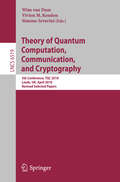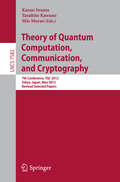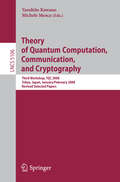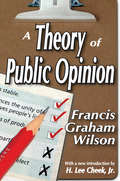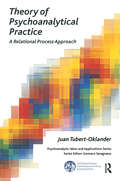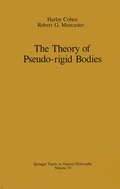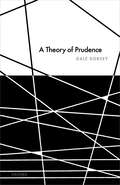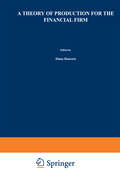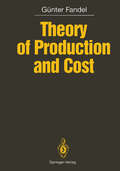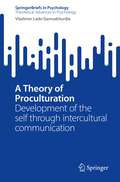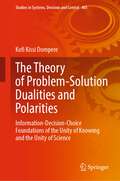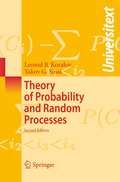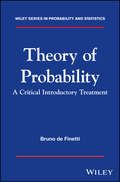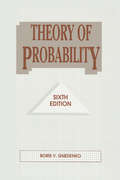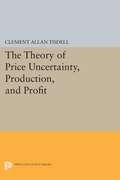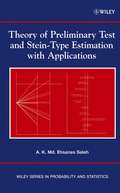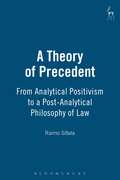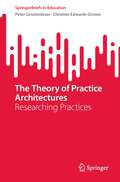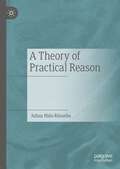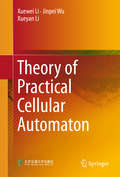- Table View
- List View
Theory of Quantum Computation, Communication and Cryptography: 5th Conference, TQC 2010, Leeds, UK, April 13-15, 2010, Revised Selected Papers (Lecture Notes in Computer Science #6519)
by Wim Van Dam Vivien M. Kendon Simone SeveriniThis book constitutes the thoroughly refereed post-conference proceedings of the 5th Conference on Theory of Quantum Computation, Communication, and Cryptography, TQC 2010, held in Leeds, UK, in April 2010. The 15 revised papers presented were carefully selected during two rounds of reviewing and improvement. Focussing on theoretical aspects of quantum computation, quantum communication, and quantum cryptography - part of a larger interdisciplinary field embedding information science in a quantum mechanical framework - the papers present current original research. Topics addressed include quantum algorithms, models of quantum computation, quantum complexity theory, simulation of quantum systems, quantum cryptography, quantum communication, quantum estimation and measurement, quantum noise, quantum coding theory, fault-tolerant quantum computing, and entanglement theory.
Theory of Quantum Computation, Communication, and Cryptography: 7th Conference, TQC 2012, Tokyo, Japan, May 17-19, 2012, Revised Selected Papers (Lecture Notes in Computer Science #7582)
by Kazuo Iwama Yasuhito Kawano Mio MuraoThis book constitutes revised selected papers from the 7th Conference on Theory of Quantum Computation, Communication, and Cryptography, TQC 2012, held in Tokyo, Japan, in May 2012. The 12 papers presented were carefully reviewed and selected for inclusion in this book. They contain original research on the rapidly growing, interdisciplinary field of quantum computation, communication and cryptography. Topics addressed are such as quantum algorithms, quantum computation models, quantum complexity theory, simulation of quantum systems, quantum programming languages, quantum cryptography, quantum communication, quantum estimation, quantum measurement, quantum tomography, completely positive maps, decoherence, quantum noise, quantum coding theory, fault-tolerant quantum computing, entanglement theory, and quantum teleportation.
Theory of Quantum Computation, Communication, and Cryptography: Third Workshop, TQC 2008 Tokyo, Japan, January 30 - February 1, 2008, Revised Selected Papers (Lecture Notes in Computer Science #5106)
by Yasuhito Kawano Michele MoscaThis book constitutes the thoroughly refereed post-workshop proceedings of the Third Workshop on Theory of Quantum Computation, Communication, and Cryptography, TQC 2008, held in Tokyo, Japan, in January/February 2008. The 10 revised full papers presented were carefully selected during two rounds of reviewing and improvement. The papers present current original research and focus on theoretical aspects of quantum computation, quantum communication, and quantum cryptography, which are part of a larger interdisciplinary field that casts information science in a quantum mechanical framework.
A Theory of Public Opinion
by Francis WilsonThis book traces the emergence of the ideas and institutions that evolved to give people mastery over their own destiny through the force of public opinion. The Greek belief in citizen participation is shown as the ground upon which the idea of public opinion began and grew. For Wilson, public opinion is an "orderly force," contributing to social and political life. Wilson appraises the influence of modern psychology and the slow appearance of methodologies that would enable people not only to measure the opinions of others, but to mold them as well. He examines the relation of the theory of public opinion to the intellectuals, the middle class, and the various revolutionary and proletarian movements of the modern era. The circumstances in which the individual may refuse to follow the opinions of the experts are succinctly and movingly analyzed. This book is a historical and philosophical evaluation of a concept that has played a decisive part in history, and whose overwhelming force is underestimated. The author's insight brings an understanding that is invaluable at a time when public opinion, the force developed to enable the ruled to restrain their rulers, has become controllable. Attempts to manipulate it are made by those who would impose their will upon their fellow men.
A Theory of Public Opinion: Philosophical And Historical Studies, V2
by Francis WilsonThis book traces the emergence of the ideas and institutions that evolved to give people mastery over their own destiny through the force of public opinion. The Greek belief in citizen participation is shown as the ground upon which the idea of public opinion began and grew. For Wilson, public opinion is an "orderly force," contributing to social and political life. Wilson appraises the influence of modern psychology and the slow appearance of methodologies that would enable people not only to measure the opinions of others, but to mold them as well. He examines the relation of the theory of public opinion to the intellectuals, the middle class, and the various revolutionary and proletarian movements of the modern era. The circumstances in which the individual may refuse to follow the opinions of the experts are succinctly and movingly analyzed. This book is a historical and philosophical evaluation of a concept that has played a decisive part in history, and whose overwhelming force is underestimated. The author's insight brings an understanding that is invaluable at a time when public opinion, the force developed to enable the ruled to restrain their rulers, has become controllable. Attempts to manipulate it are made by those who would impose their will upon their fellow men.
Theory of Psychoanalytical Practice: A Relational Process Approach (The International Psychoanalytical Association Psychoanalytic Ideas and Applications Series)
by Juan Tubert-OklanderThis book makes an original contribution to the study of the psychoanalytic process from a relational point of view, and at the same time serves as a textbook on the theory of technique. It provides a general exposition of the theory of psychoanalytic practice from a process perspective that emphasizes the analytic relationship, the dyadic nature of the psychoanalytic situation, and the impact of unconscious interaction between its two parties, and also includes the authors personal point of view and contributions on the subject.
Theory of Psychoanalytical Practice: A Relational Process Approach (The International Psychoanalytical Association Psychoanalytic Ideas and Applications Series)
by Juan Tubert-OklanderThis book makes an original contribution to the study of the psychoanalytic process from a relational point of view, and at the same time serves as a textbook on the theory of technique. It provides a general exposition of the theory of psychoanalytic practice from a process perspective that emphasizes the analytic relationship, the dyadic nature of the psychoanalytic situation, and the impact of unconscious interaction between its two parties, and also includes the authors personal point of view and contributions on the subject.
The Theory of Pseudo-rigid Bodies (Springer Tracts in Natural Philosophy #33)
by Harley Cohen Robert G. MuncasterThis monograph concerns the development, analysis, and application of the theory of pseudo-rigid bodies. It collects together our work on that subject over the last five years. While some results have appeared else where, much of the work is new. Our objective in writing this mono graph has been to present a new theory of the deformation of bodies, one that has not only a firm theoretical basis, but also the simplicity to serve as an effective tool in practical problems. Consequently, the main body of the treatise is a multifaceted development of the theory, from foundations to explicit solutions to linearizations to methods of approximation. The fact that this variety of aspects, each examined in considerable detail, can be collected together in a single, unified treat ment gives this theory an elegance that we feel sets it apart from many others. While our goal has always been to give a complete treatment of the theory as it now stands, the work here is not meant to be definitive. Theories are not entities that appear suddenly one day and thereafter stand as given. Rather, they must mature and grow with time and experience. Our development is more correctly a beginning, tempting others to explore, appraise, and modify its features so as to produce something better.
A Theory of Prudence
by Dale DorseyMuch of knowing what to do is knowing what to do for ourselves, but knowing how to act in our best interest is complex—-we must know what benefits us, what burdens us, and how these facts present and constitute considerations in favor of action. Additionally, we must know how we should weigh our interests at different times—-past, present, and future. Dale Dorsey argues that a theory of prudence is needed: a theory of how we ought to act when we are acting for ourselves. A Theory of Prudence provides a comprehensive account of prudence, including the metaethics of prudential value, the nature of the personal good, the reasons of prudence, and the structure of prudential normativity over time.
A Theory of Prudence
by Dale DorseyMuch of knowing what to do is knowing what to do for ourselves, but knowing how to act in our best interest is complex—-we must know what benefits us, what burdens us, and how these facts present and constitute considerations in favor of action. Additionally, we must know how we should weigh our interests at different times—-past, present, and future. Dale Dorsey argues that a theory of prudence is needed: a theory of how we ought to act when we are acting for ourselves. A Theory of Prudence provides a comprehensive account of prudence, including the metaethics of prudential value, the nature of the personal good, the reasons of prudence, and the structure of prudential normativity over time.
A Theory of Production for the Financial Firm (Innovations in Financial Markets and Institutions #4)
by Diana HancockFurthermore, if the effects of regulations on user costs are excluded, it is impossible to analyze monetary policy effects. Chapter 2 examines the principal areas of regulation that affect user costs. For example, reserve requirements, as administered by the Federal Reserve, act as a tax on financial firms so covered. Required reserves earn no return to the financial firm and there is foregone revenue. Deposit insurance increases the user cost of servicing deposits to the banks. Interest rate regulations place limits on interest rates on time de posits, or prohibit payments on demand deposits during part of the period studied. Underlying all these are the open market operations of the Federal Reserve, and their effects on interest rates and the quantities of financial goods. Chapter 2 reveals that previous work on the estimation of bank tech nologies is incomplete, and that the regulations require modelling as a part of the profit maximizing structure. 1.3 User Cost Derivation Chapter 3 discusses the construction of user costs. These are derived for the services from all assets or liabilities on a bank balance sheet or appearing on the income statement. The user cost formulation permits goods to be classified as outputs and inputs. Those with a positive user cost, where expenditures per unit exceed revenues per unit, are inputs. The unit for financial goods such as loans or deposits is one dollar per period. Goods with a negative user cost, with expenditures falling below revenue per unit, are outputs.
Theory of Production and Cost
by Günter FandelProduction theory and the theory of cost both belong to the central areas of business administration, for all considerations concerning the economic organization of industrial manufacturing processes start from these. Two developments in the past 30 years have had a considerable influence on the structure and the concentration on points of emphasis in this book. I am referring to findings from KOOPMANS' activity analysis and to the formulation by GUTENBERG of a production function concept that focuses on industrial production processes. Activity analysis has made it possible to develop, from a uniform approach, different types of production functions which describe the concrete principles of production in the productive sector of a business enterprise; this has created a common basis for all production concepts in business administration. The Gutenberg Production Function with its different kinds of adjustment to a changing output has opened up a flexibility to theoretical and practical considerations that gave rise to a large number of additional studies in this area. Considerations in cost theory were in particular need of considerable extensions in the direction of cost minimal combined adjustment processes. By means of the organization of its contents, this book will take both approaches into due account. In that way, it is vastly different from other books dealing with the same subject. As a matter of course, traditional analytical methods and ways of thinking also constitute a large part of the book.
A Theory of Proculturation: Development of the self through intercultural communication (SpringerBriefs in Psychology)
by Vladimer Lado GamsakhurdiaIn each connection with new cultural contexts a new hybrid state of cultural adaptation is constructed enabling people to adjust to new conditions by creating innovative solutions for the self. This book aims to provide a brief presentation of innovative cultural psychological theory of proculturation reflecting and oriented on the understanding of semiotic and developmental dynamics of higher mental phenomena while engaging alien signs through intercultural communication. The exploration and theoretical understanding of developmental dynamics (such as self and identity construction) of people who live in immigration or multicultural, or even multi-ethnic societies, the research builds its new focus in contrasts with the acculturation theories currently present in social psychology. The theory of proculturation has been built in opposition to cross-cultural psychological theories as well as mainstream theories of acculturation research dominated by bidimensional theoretical models. Instead, this theory is constructed based on theoretical explorations which are rooted in cultural semiotics and developmental psychological paradigm on human psychology.
The Theory of Problem-Solution Dualities and Polarities: Information-Decision-Choice Foundations of the Unity of Knowing and the Unity of Science (Studies in Systems, Decision and Control #405)
by Kofi Kissi DompereThis book is concerned with the development of the understanding of the relational structures of information, knowledge, decision–choice processes of problems and solutions in the theory and practice regarding diversity and unity principles of knowing, science, non-science, and information–knowledge systems through dualistic-polar conditions of variety existence and nonexistence. It is a continuation of the sequence of my epistemic works on the theories on fuzzy rationality, info-statics, info-dynamics, entropy, and their relational connectivity to information, language, knowing, knowledge, cognitive practices relative to variety identification–problem–solution dualities, variety transformation–problem–solution dualities, and variety certainty–uncertainty principle in all areas of knowing and human actions regarding general social transformations. It is also an economic–theoretic approach in understanding the diversity and unity of knowing and science through neuro-decision–choice actions over the space of problem–solution dualities and polarities. The problem–solution dualities are argued to connect all areas of knowing including science and non-science, social science, and non-social-science into unity with diversities under neuro-decision–choice actions to support human existence and nonexistence over the space of static–dynamic dualities. The concepts of diversity and unity are defined and explicated to connect to the tactics and strategies of decision–choice actions over the space of problem–solution dualities. The concepts of problem and solution are defined and explicated not in the space of absoluteness but rather in the space of relativity based on real cost–benefit conditions which are shown to be connected to the general parent–offspring infinite process, where every solution generates new problem(s) which then generates a search for new solutions within the space of minimum–maximum dualities in the decision–choice space under the principle of non-satiation over the space of preference–non-preference dualities with analytical tools drawn from the fuzzy paradigm of thought which connects the conditions of the principle of opposites to the conditions of neuro-decision–choice actions in the zone of variety identifications and transformations. The Monograph would be useful to all areas of Research, Learning and Teaching at Advanced Stages of Knowing and Knowledge Production.
Theory of Probability and Random Processes (Universitext)
by Leonid Koralov Yakov G. SinaiA one-year course in probability theory and the theory of random processes, taught at Princeton University to undergraduate and graduate students, forms the core of this book. It provides a comprehensive and self-contained exposition of classical probability theory and the theory of random processes. The book includes detailed discussion of Lebesgue integration, Markov chains, random walks, laws of large numbers, limit theorems, and their relation to Renormalization Group theory. It also includes the theory of stationary random processes, martingales, generalized random processes, and Brownian motion.
Theory of Probability: A critical introductory treatment (Wiley Series in Probability and Statistics #6)
by Bruno de FinettiFirst issued in translation as a two-volume work in 1975, this classic book provides the first complete development of the theory of probability from a subjectivist viewpoint. It proceeds from a detailed discussion of the philosophical mathematical aspects to a detailed mathematical treatment of probability and statistics. De Finetti’s theory of probability is one of the foundations of Bayesian theory. De Finetti stated that probability is nothing but a subjective analysis of the likelihood that something will happen and that that probability does not exist outside the mind. It is the rate at which a person is willing to bet on something happening. This view is directly opposed to the classicist/ frequentist view of the likelihood of a particular outcome of an event, which assumes that the same event could be identically repeated many times over, and the 'probability' of a particular outcome has to do with the fraction of the time that outcome results from the repeated trials.
Theory of Probability: A critical introductory treatment (Wiley Series in Probability and Statistics #6)
by Bruno de FinettiFirst issued in translation as a two-volume work in 1975, this classic book provides the first complete development of the theory of probability from a subjectivist viewpoint. It proceeds from a detailed discussion of the philosophical mathematical aspects to a detailed mathematical treatment of probability and statistics. De Finetti’s theory of probability is one of the foundations of Bayesian theory. De Finetti stated that probability is nothing but a subjective analysis of the likelihood that something will happen and that that probability does not exist outside the mind. It is the rate at which a person is willing to bet on something happening. This view is directly opposed to the classicist/ frequentist view of the likelihood of a particular outcome of an event, which assumes that the same event could be identically repeated many times over, and the 'probability' of a particular outcome has to do with the fraction of the time that outcome results from the repeated trials.
Theory of Probability
by Boris V. GnedenkoThis book is the sixth edition of a classic text that was first published in 1950 in the former Soviet Union. The clear presentation of the subject and extensive applications supported with real data helped establish the book as a standard for the field. To date, it has been published into more that ten languages and has gone through five editions. The sixth edition is a major revision over the fifth. It contains new material and results on the Local Limit Theorem, the Integral Law of Large Numbers, and Characteristic Functions. The new edition retains the feature of developing the subject from intuitive concepts and demonstrating techniques and theory through large numbers of examples. The author has, for the first time, included a brief history of probability and its development. Exercise problems and examples have been revised and new ones added.
Theory of Probability
by Boris V. GnedenkoThis book is the sixth edition of a classic text that was first published in 1950 in the former Soviet Union. The clear presentation of the subject and extensive applications supported with real data helped establish the book as a standard for the field. To date, it has been published into more that ten languages and has gone through five editions. The sixth edition is a major revision over the fifth. It contains new material and results on the Local Limit Theorem, the Integral Law of Large Numbers, and Characteristic Functions. The new edition retains the feature of developing the subject from intuitive concepts and demonstrating techniques and theory through large numbers of examples. The author has, for the first time, included a brief history of probability and its development. Exercise problems and examples have been revised and new ones added.
The Theory of Price Uncertainty, Production, and Profit
by Clement Allan TisdellFirms and farmers, under pure competition, must make production decisions in the face of price uncertainty. The author has integrated diverse theories of behavior under uncertainty to provide a new framework for his mathematical analysis of the impact of price uncertainty on the behavior of the firm. Drawing upon the work of Knight, Hicks, von Neumann, and Morgenstern, he develops a schema that accounts for a greater diversity of behavior than do existing theories, yet one which yields simple economic theorems of practical value. The conclusions he draws apply to both socialist and capitalist economics.Originally published in 1968.The Princeton Legacy Library uses the latest print-on-demand technology to again make available previously out-of-print books from the distinguished backlist of Princeton University Press. These editions preserve the original texts of these important books while presenting them in durable paperback and hardcover editions. The goal of the Princeton Legacy Library is to vastly increase access to the rich scholarly heritage found in the thousands of books published by Princeton University Press since its founding in 1905.
Theory of Preliminary Test and Stein-Type Estimation with Applications (Wiley Series in Probability and Statistics #517)
by A. K. SalehTheory of Preliminary Test and Stein-Type Estimation with Applications provides a com-prehensive account of the theory and methods of estimation in a variety of standard models used in applied statistical inference. It is an in-depth introduction to the estimation theory for graduate students, practitioners, and researchers in various fields, such as statistics, engineering, social sciences, and medical sciences. Coverage of the material is designed as a first step in improving the estimates before applying full Bayesian methodology, while problems at the end of each chapter enlarge the scope of the applications. This book contains clear and detailed coverage of basic terminology related to various topics, including: * Simple linear model; ANOVA; parallelism model; multiple regression model with non-stochastic and stochastic constraints; regression with autocorrelated errors; ridge regression; and multivariate and discrete data models * Normal, non-normal, and nonparametric theory of estimation * Bayes and empirical Bayes methods * R-estimation and U-statistics * Confidence set estimation
A Theory of Precedent: From Analytical Positivism to a Post-Analytical Philosophy of Law
by Raimo SiltalaAnalytical jurisprudence has been mostly silent on the role of precedent in legal adjudication. What is the content of a judge's precedent ideology,or the rule of precedent-recognition, by means of which the ratio of a case is to be distinguished from mere dicta? In this study, the author identifies six types of judicial precedent-ideology, among them judicial legislation, systemic construction of the underlying reasons of law in the Dworkinian sense, and a radical re-evaluation of the merits of a prior case in later adjudication, as envisioned by the American Realists. These competing models are tested against judicial experiences in the UK, US, France, Italy, Germany and Finland. By this means Lon Fuller's famous 'internal morality of law' is shown to function rather poorly in the context of precedents, and the author therefore suggests a redefinition of the rule which makes it work for precedent. This, in turn leads the author to confront fundamental questions about the normative nature of law. Is Kelsen's grundnorm or Hart's ultimate rule of recognition a valid rule, in the image of legal rules proper, or is it merely a social fact, observable only in the practices and behaviour of judges and other officials? The author claims that Hart is caught between Kelsen and J.L. Borges, the late Argentinian fabulist, in so far as the ontology and epistemology of the rule of recognition are concerned. This leads the author to the conclusion that the two predicaments affecting analytical positivism, namely the threat of endless self-referentiality, or infinite regress, can only be accounted for by means of recourse to the philosophy of deconstruction as posited by Jacques Derrida.
The Theory of Practice Architectures: Researching Practices (SpringerBriefs in Education)
by Peter Grootenboer Christine Edwards-GrovesThis book provides an overview of the Theory of Practice Architectures (TPA), and the associated Theory of Ecology of Practices, in a manner accessible for a broader audience. The authors are part of the authorial team that developed the Theory of Practice Architectures from a strong empirical base, with its initial publication in 'Changing Practices, Changing Education' (Kemmis et al., Springer, 2014). This book follows on from that publication with a singluar focus on the Theory of Practice Architectures, and shows how it can be used as a theoretical framework for a range of empirical research projects. It first outlines and describes both the Theory of Practice Architectures and the Theory of Ecology of Practices, illustrating them with a range of relevant practical examples. Then, it focuses explicitly on designing and undertaking empirical research, analyzing data and reporting findings using the Theory of Practice Architectures. In this way, this book shows specifically and overtly explicate ways that research can be designed, and how data can be collected and analyzed, drawing on the Theory of Practice Architectures as a foundational framework. It also showcases a range of specific examples to allow readers to see the ideas as they have been employed in practice.
A Theory of Practical Reason
by Julian Nida-RümelinIn this book, German philosopher Julian Nida-Rümelin presents a theory of practical reason that is objectivist, or rather realist, as an alternative to the widespread subjectivism in the theory of rationality. This theory has pragmatic traits that can be read as a constructive counterpart to Nida-Rümelin's critique of consequentialism whilst embedding its conception of rationality in the conceptual framework of decision and game theory.
Theory of Practical Cellular Automaton
by Xuewei Li Jinpei Wu Xueyan LiThis book addresses the intellectual foundations, function, modeling approaches and complexity of cellular automata; explores cellular automata in combination with genetic algorithms, neural networks and agents; and discusses the applications of cellular automata in economics, traffic and the spread of disease. Pursuing a blended approach between knowledge and philosophy, it assigns equal value to methods and applications.
